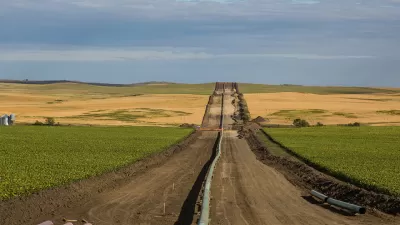The 2005 Supreme Court decision on Kelo v. New London was a landmark in eminent domain law, paving the way for Pfizer to develop there. Four years later, Pfizer is pulling up stakes.
The City of New London won its Supreme Court battle against residents in the Fort Trumbull neighborhood of New London: the Court ruled that municipalities can use eminent domain to take private land and give it to another private entity for economic development. But it hardly seems like a win today as the Fort Trumbull neighborhood is filled with barren lots and the private developer - Pfizer - has decided to leave New London.
An editorial in the Hartford Courant sees a silver lining:
"Pfizer will leave behind prime space that should attract the kind of taxpaying tenant New London badly needs. And the adjoining Fort Trumbull neighborhood of modest homes taken by eminent domain and torn down to make way for an upscale urban village - and to entice Pfizer to the site - is now ready for just that kind of development, once the economy recovers."
Thanks to Rebecca Sanborn Stone
FULL STORY: Pfizer's Leaving - But New London Opportunities Remain

Trump Administration Could Effectively End Housing Voucher Program
Federal officials are eyeing major cuts to the Section 8 program that helps millions of low-income households pay rent.

Planetizen Federal Action Tracker
A weekly monitor of how Trump’s orders and actions are impacting planners and planning in America.

The 120 Year Old Tiny Home Villages That Sheltered San Francisco’s Earthquake Refugees
More than a century ago, San Francisco mobilized to house thousands of residents displaced by the 1906 earthquake. Could their strategy offer a model for the present?

HSR Reaches Key Settlement in Northern California City
The state’s high-speed rail authority reached an agreement with Millbrae, a key city on the train’s proposed route to San Francisco.

Washington State Legislature Passes Parking Reform Bill
A bill that would limit parking requirements for new developments is headed to the governor’s desk.

Missouri Law Would Ban Protections for Housing Voucher Users
A state law seeks to overturn source-of-income discrimination bans passed by several Missouri cities.
Urban Design for Planners 1: Software Tools
This six-course series explores essential urban design concepts using open source software and equips planners with the tools they need to participate fully in the urban design process.
Planning for Universal Design
Learn the tools for implementing Universal Design in planning regulations.
Ada County Highway District
Clanton & Associates, Inc.
Jessamine County Fiscal Court
Institute for Housing and Urban Development Studies (IHS)
City of Grandview
Harvard GSD Executive Education
Toledo-Lucas County Plan Commissions
Salt Lake City
NYU Wagner Graduate School of Public Service



























